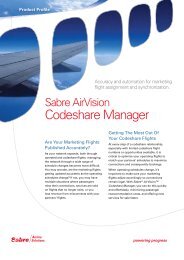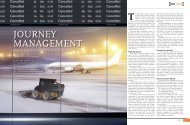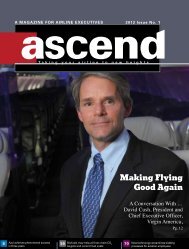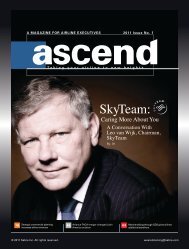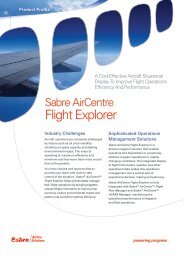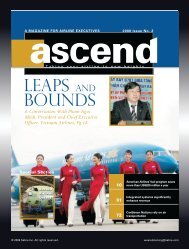2009 Issue 1 - Sabre Airline Solutions
2009 Issue 1 - Sabre Airline Solutions
2009 Issue 1 - Sabre Airline Solutions
You also want an ePaper? Increase the reach of your titles
YUMPU automatically turns print PDFs into web optimized ePapers that Google loves.
many of the larger aircraft that offer service that<br />
in some essence parallels first-class service on<br />
the mainline narrow-body aircraft. While some<br />
will argue that the larger and more spacious<br />
seats are there primarily for marketing purposes,<br />
only time will tell what happens to these cabins<br />
when carriers are free to allocate aircraft to either<br />
the main operations or regional partners.<br />
Other carriers have simply opted to have<br />
the larger aircraft flown in house by their unionized<br />
crewmembers and benefit from the other<br />
cost savings of having a more homogeneous<br />
fleet ranging in seat capacity from 70 to, in some<br />
cases, 110 seats. These savings include but are<br />
not limited to the purchasing of in-flight products<br />
and services, procurement of ground support<br />
equipment, engine maintenance and spares, and,<br />
in some cases, joint flight attendant training.<br />
The lingering issue of who will fly the<br />
larger regional jets — such as the Embraer<br />
E190, Embraer E195, Bombardier CRJ-1000 and<br />
proposed Bombardier C-Series — will continue<br />
until major network carriers first and foremost<br />
address the scope clause issue as part of their<br />
pilot contract negotiations and decide which<br />
direction they will go with their narrow-body fleet<br />
replacement plans.<br />
In general, the airline community has two<br />
purchasing options:<br />
Embrace the family of regional jets and assign<br />
their flying as dictated by pilot contracts,<br />
Preserve the status quo and order next-generation<br />
narrow-body aircraft that will be produced<br />
by Airbus and Boeing.<br />
The only caveat is that these aircraft<br />
manufacturers are in no hurry to launch these<br />
programs as they continue to sell the venerable<br />
Boeing Next-Generation 737s and the Airbus<br />
A320 family of aircraft. For some airlines, however,<br />
the deadline and/or need to order new<br />
narrow-body aircraft is fast approaching, and<br />
they have been forced, in some cases unwillingly,<br />
to order additional aircraft from the current<br />
generation of narrow bodies. In addition, since<br />
most pilot contracts are not yet up for renewal<br />
at the top major network carriers, it’s business<br />
as usual for now.<br />
However, the new Delta Air Lines’ inherited<br />
fleet of aging yet dependable Northwest<br />
<strong>Airline</strong>s’ Douglas DC-9s will soon reach their<br />
end, and only time will tell how Delta Air Lines<br />
will replace them.<br />
Prior to the merger, Northwest <strong>Airline</strong>s<br />
had established a new subsidiary — Compass<br />
<strong>Airline</strong>s — to fly a fleet of Embraer E-175 and<br />
Bombardier CRJ-900s from its three main hub<br />
airports. Initially, these operations were used to<br />
supplement its mainline operations, but it was<br />
apparent to those in the industry that Compass<br />
<strong>Airline</strong>s was a feeding ground for gaining the<br />
necessary experience with the mid-range to<br />
larger regional carriers to decide which direction<br />
to go with the DC-9 replacement. It has often<br />
been reported in the press as one of the leading<br />
contenders for launching the Bombardier CRJ<br />
Series aircraft as the replacement aircraft for the<br />
sizeable DC-9 fleet.<br />
Currently, Northwest <strong>Airline</strong>s operates<br />
approximately 65 DC-9 aircraft, down from a<br />
high of more than 100 aircraft before the economic<br />
downturn and sky-rocketing fuel prices.<br />
The introduction of newer and much more<br />
fuel-efficient aircraft in its domestic operations<br />
could fundamentally change its current route<br />
structure.<br />
The future role of regional airline operations<br />
in the U.S. domestic system goes without<br />
saying. For Delta Air Lines, its decision to maintain<br />
seven major hub airports will only re-enforce its<br />
need for a strong, efficient regional aircraft fleet<br />
and network structure. For any network carrier<br />
to be successful, it must provide high-frequency<br />
connections between airport hubs so it can flow<br />
passengers to the appropriate gateway for their<br />
international destinations.<br />
Delta Air Lines has designated Atlanta<br />
and Cincinnati as major international gateways to<br />
Europe and Latin America; New York as a gateway<br />
to Europe and beyond; and Los Angeles,<br />
Minneapolis-St Paul and Tokyo as primary gateways<br />
to Asia/Pacific. The remaining hub airports<br />
will continue to play an active role in the flow<br />
of domestic passengers and potentially provide<br />
alternate gateways to various regions in the<br />
world. The need for high-frequency service will<br />
call for smaller capacity aircraft that can support<br />
hub-to-hub flying, especially between the closely<br />
located hubs of Detroit and Cincinnati on the<br />
one hand and Memphis and Atlanta on the other<br />
hand. It’s impractical for Delta Air Lines to offer<br />
Major Network<br />
<strong>Airline</strong><br />
Delta Air Lines<br />
Northwest <strong>Airline</strong>s<br />
multiple trans-Atlantic service from all of its hub<br />
airports beyond the major European gateways<br />
of its alliance partners. For example, if a traveler<br />
chooses to fly from Düsseldorf, Germany, or<br />
Nice, France, he would have to fly through New<br />
York or Atlanta.<br />
Regional carriers aligned with Delta Air<br />
Lines are well positioned to reap the benefits of<br />
being associated with the world’s largest carrier.<br />
However, it remains to be seen how Delta Air<br />
Lines’ executes on its overall strategic plan,<br />
which will include how to effectively balance<br />
competing hub airports, manage the flow of passengers<br />
and aircraft throughout its network system,<br />
collaborate and manage its multiple regional<br />
airline operations, and ultimately make effective<br />
fleet renewal decisions to drive and sustain the<br />
efficiencies of its massive global network.<br />
Within the context of a global airline alliance,<br />
the number of destinations served by the<br />
main players will dictate the attractiveness of the<br />
alliance network to the business community and<br />
the general traveling public. The ability to serve a<br />
diverse range of destinations in terms of market<br />
distance and customer demand will mean that<br />
regional carriers will have an important role to<br />
play in connecting the dots across the U.S.<br />
domestic network. a<br />
Michael Clarke is director of optimization<br />
solutions in airline operations for <strong>Sabre</strong><br />
<strong>Airline</strong> <strong>Solutions</strong>®. He can be contacted<br />
at michael.clarke@sabre.com.<br />
Regional Partner (Number Of<br />
Assigned Aircraft/On Order)<br />
Atlantic Southeast <strong>Airline</strong>s (SkyWest) – 161<br />
Chautauqua (Republic) – 37<br />
Comair – 141<br />
Freedom <strong>Airline</strong>s (Mesa) – 42<br />
Pinnacle – 16<br />
Shuttle America (Republic) – 15<br />
SkyWest <strong>Airline</strong>s – 91<br />
Compass <strong>Airline</strong>s – 36<br />
Mesaba <strong>Airline</strong>s – 53<br />
Pinnacle <strong>Airline</strong>s – 133<br />
Prior to its merger with Northwest <strong>Airline</strong>s, Delta Air lines ceased operations<br />
with regional partners Big sky <strong>Airline</strong>s and expressJet <strong>Airline</strong>s. the combined airline will<br />
continue its partnerships with 10 of its existing regional operators.<br />
ascend<br />
23<br />
regional




